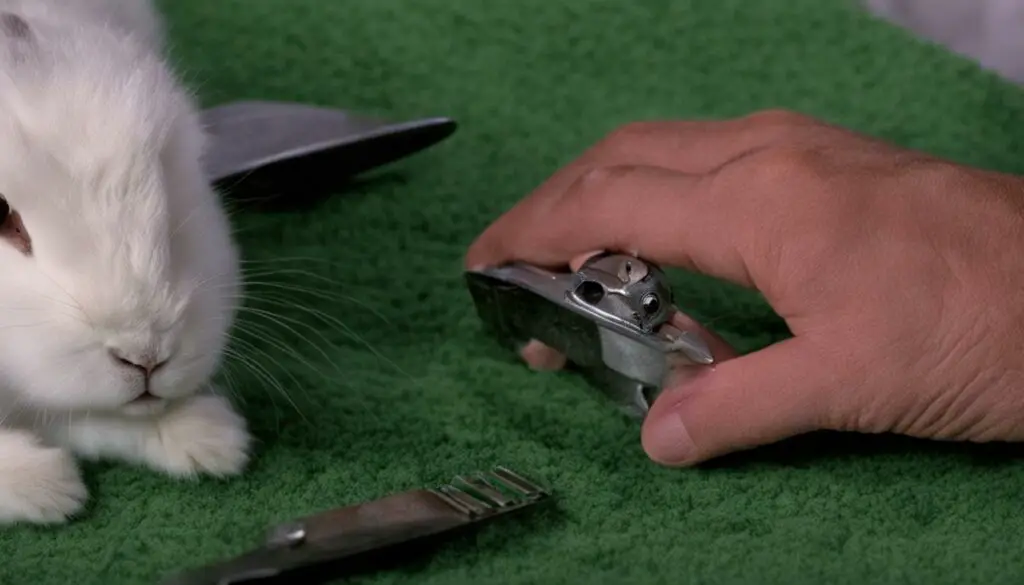Greetings fellow rabbit lovers! Today, I want to talk to you about an important aspect of your furry friend’s well-being – rabbit nail trimming. As you may know, rabbits have continuously growing nails, just like their teeth. While wild rabbits naturally wear down their nails through their activities, pet rabbits often need a little help to keep their nails at a proper length. In this guide, I’ll walk you through everything you need to know about DIY rabbit nail trimming and the importance it holds for your bunny’s health.
Key Takeaways:
- Rabbits’ nails continuously grow and often require trimming to prevent potential issues.
- Nail trimming is crucial to prevent nails from getting caught on objects or causing sore hocks.
- Knowing the anatomy of a rabbit’s nail, especially the quick, is essential to avoid pain and bleeding.
- Regular monitoring and trimming every three weeks to one month is recommended.
- Proper handling, the right tools, and a step-by-step approach make nail trimming easier.
Rabbit Nail Anatomy
Understanding the anatomy of a rabbit’s nails is essential when it comes to trimming them safely and effectively. Rabbits have a total of eighteen nails, with four on each back paw and five on each front paw. Each nail has a dark line called the quick, which is a vein that should not be cut or clipped. Accidentally cutting the quick can be painful for the rabbit and lead to bleeding. While the quick can be difficult to see, especially on darker colored nails, gently squeezing the nails before cutting can help locate its position.
It is important to note that the length of a rabbit’s nails can vary. However, when it comes to trimming, it is best to focus on only trimming the tip of the nails. In general, a rabbit’s nails should not be too long to the point where they curl under or cause discomfort. Regular trimming will help maintain the appropriate length and prevent any issues associated with overgrown nails.
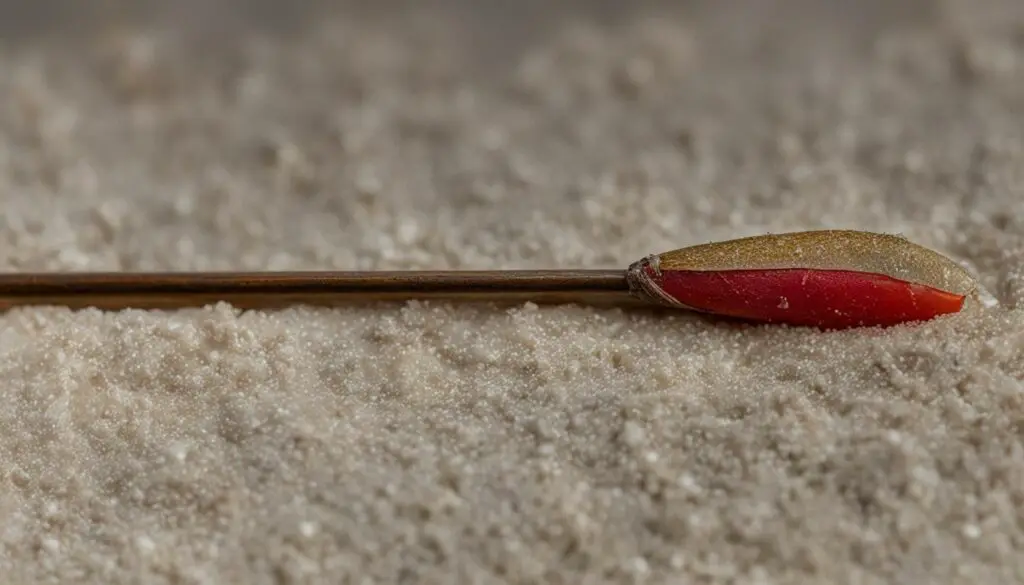
Quick Summary:
- Rabbits have a total of eighteen nails, with four on each back paw and five on each front paw.
- The dark line in the nail is called the quick, which is a vein that should not be cut or clipped.
- Gently squeezing the nails before cutting can help locate the position of the quick.
- When trimming, focus on trimming only the tip of the nails.
- Regular trimming helps maintain appropriate nail length and prevents issues associated with overgrown nails.
How Often Should You Trim Your Rabbit’s Nails?
When it comes to rabbit nail trimming, maintaining a regular schedule is crucial for their health and comfort. But how often should you trim your rabbit’s nails? The frequency may vary depending on the individual rabbit, but a general guideline is to check and trim their nails every three weeks to one month.
Regular monitoring is essential to ensure that the nails do not become too long and potentially cause discomfort or problems. Checking your rabbit’s nails every week or so, as part of your grooming routine, can help you stay on top of their nail care.
Remember, by staying consistent with nail trimming, you can prevent issues like nails getting caught on objects or curling under and causing sore hocks. Ensuring that your rabbit’s nails are at a comfortable length is an important aspect of their overall well-being.
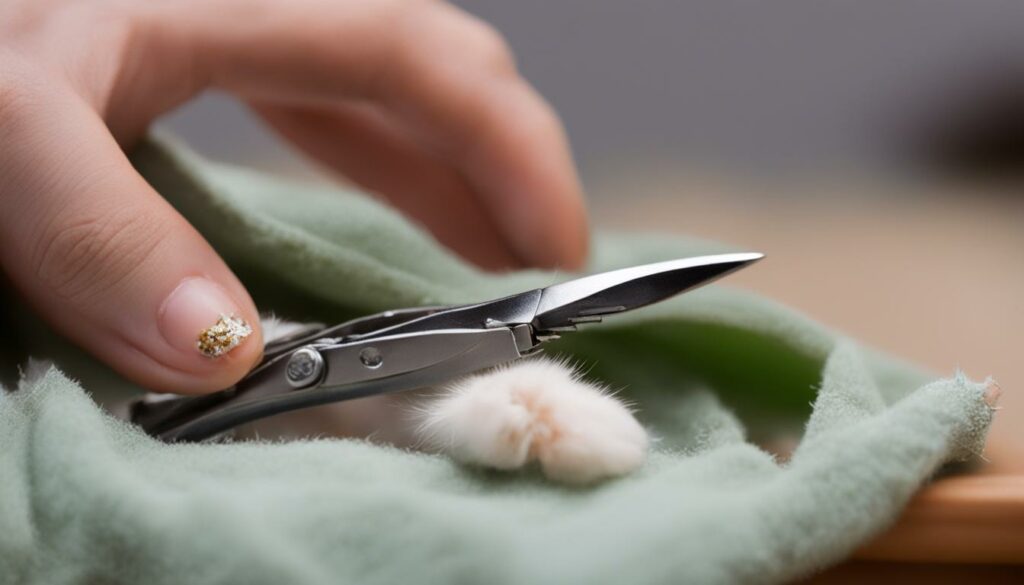
The Signs that Your Rabbit’s Nails Need Trimming
While the recommended timeframe for trimming rabbit nails is every three weeks to one month, it’s also important to pay attention to certain signs that indicate your rabbit’s nails may need trimming sooner. If you hear clicking noises as your rabbit walks, notice their nails catching on objects, or see their nails curling under, it’s a clear indication that a nail trim is due.
Tips for a Successful Nail Trimming Session
When trimming your rabbit’s nails, it’s important to approach the task with patience and a calm demeanor. Here are a few tips to help make the process go smoothly:
- Choose a quiet and comfortable environment for the nail trimming session.
- Gently hold your rabbit, ensuring they feel secure and supported.
- Use proper nail clippers designed for small animals or rabbits to make precise cuts.
- If you accidentally cut into the quick and the nail starts bleeding, have styptic powder or cornstarch on hand to stop the bleeding.
- Provide positive reinforcement such as treats and praise throughout the trimming session to keep your rabbit calm and cooperative.
By following these guidelines and working at a pace that suits your rabbit, you can establish a regular nail trimming routine that keeps their nails at a comfortable length and promotes their overall well-being.
Rabbit Nail Clipping, Step by Step
Properly trimming your rabbit’s nails is an important part of their overall health and well-being. While the process can seem daunting at first, with the right tools and techniques, nail clipping can become a stress-free routine for both you and your bunny.
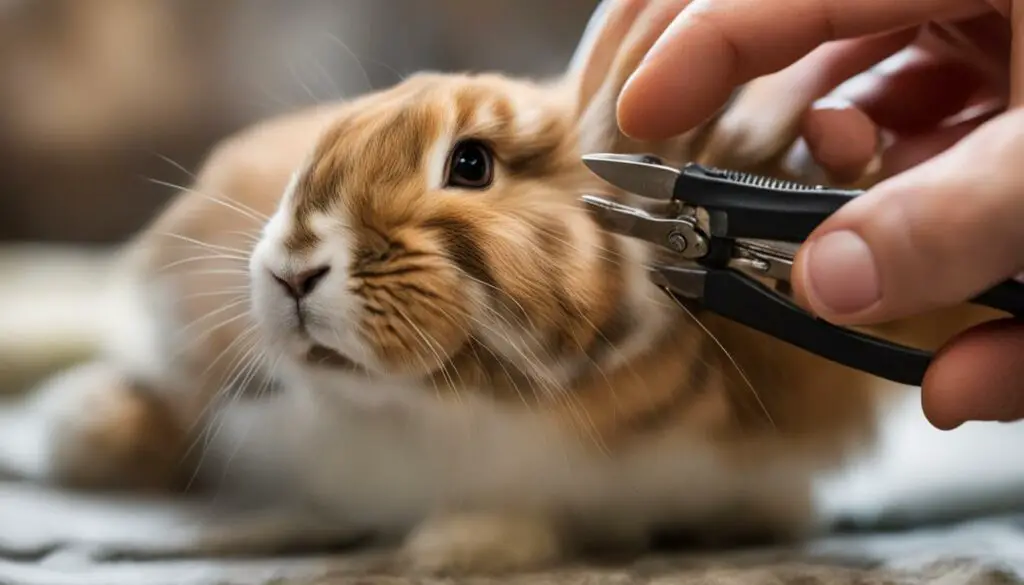
Gathering the Necessary Tools
Before you start the nail clipping process, gather the necessary tools. You will need a towel to wrap your bunny in, nail clippers specifically designed for small animals or rabbits, cotton swabs, styptic powder or cornstarch in case of bleeding, and optionally, a pet nail file and a grooming glove for added comfort.
Towel Wrapping for Calmness and Restraint
To keep your bunny calm and prevent scratches, wrap them in a thick towel. This will provide a secure and comfortable grip while allowing you to focus on their nails.
Trimming the Nails
Using the appropriate nail clippers, trim only the tip of the nails, making sure to avoid the quick. The quick is a vein that runs inside the nail and cutting it can cause pain and bleeding. If you accidentally cut into the quick and the nail starts bleeding, apply styptic powder or cornstarch using a cotton swab to stop the bleeding.
After trimming, you can use a pet nail file to smooth any rough edges, and a grooming glove can provide extra comfort for your bunny during and after the process.
| Tools Needed for Rabbit Nail Clipping |
|---|
| Nail clippers specifically designed for small animals or rabbits |
| Towel for wrapping and restraint |
| Cotton swabs |
| Styptic powder or cornstarch for bleeding |
| Pet nail file (optional) |
| Grooming glove (optional) |
With these step-by-step instructions and the right tools, you can confidently trim your rabbit’s nails, ensuring their comfort and preventing any potential nail-related issues.
Is It Possible to Declaw a Rabbit?
Declawing a rabbit is a topic that often sparks debate among rabbit owners and animal welfare advocates. Although it is technically possible to declaw a rabbit, similar to declawing a cat, it is strongly discouraged and considered inhumane. Declawing involves the amputation of a rabbit’s toes at the first joint, which can cause significant pain, mobility issues, and long-term complications.
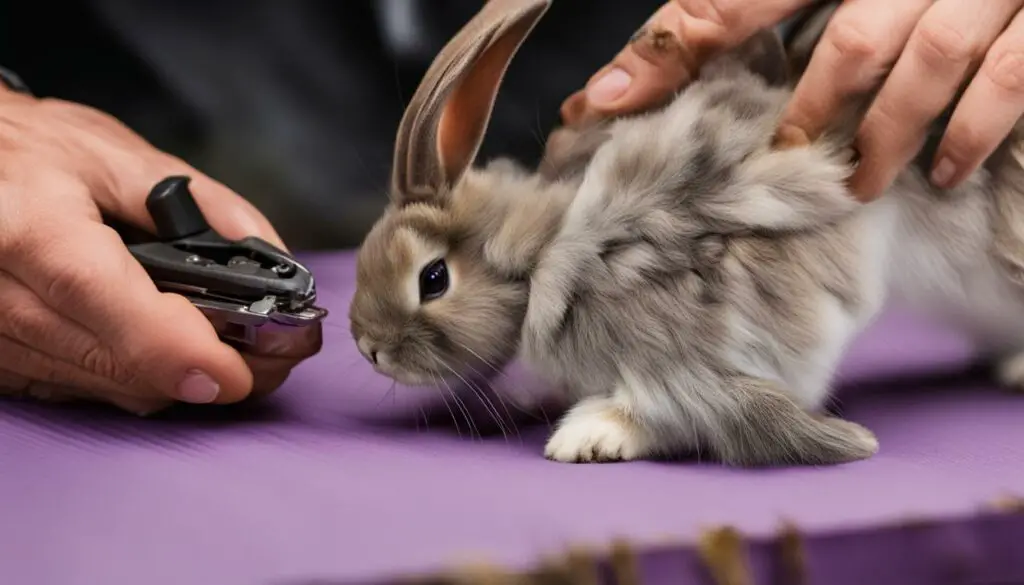
Rabbits use their nails for various purposes, including scratching, digging, and self-defense. Declawing deprives them of these natural behaviors and can have a negative impact on their physical and mental well-being. Furthermore, rabbits rely on their nails for traction and balance, and removing them can disrupt their ability to move comfortably and navigate their environment.
Reasons Not to Declaw a Rabbit
There are several compelling reasons why declawing should be avoided:
- Causes pain and discomfort: Declawing involves removing a vital part of a rabbit’s anatomy, resulting in acute pain during the procedure and potential long-term pain and sensitivity.
- Impairs mobility: Rabbits rely on their nails for various activities, and declawing can hinder their ability to walk, jump, and engage in natural behaviors.
- Increases vulnerability: Without their nails, rabbits lose an important means of self-defense, making them more vulnerable to predators or other potential dangers.
- Negative behavioral effects: Declawing can lead to behavioral issues like increased aggression, anxiety, or litter box aversion due to pain and stress.
“Declawing a rabbit is a painful and unnecessary procedure that can have far-reaching physical and psychological consequences for the animal. It is important to explore humane alternatives to maintain your rabbit’s nail length and promote their overall well-being.” – Dr. Jane Thompson, veterinarian
Instead of resorting to declawing, it is recommended to focus on other methods of nail maintenance for your rabbit, such as regular nail trimming and providing appropriate surfaces and objects for them to naturally wear down their nails. By prioritizing your rabbit’s welfare and understanding their natural behaviors, you can ensure they lead a happy and comfortable life without subjecting them to unnecessary procedures.
Other Ways to Keep Your Rabbit’s Nails Short
Rabbit nail trimming is an essential part of maintaining their overall health and preventing various issues. However, there are also natural ways to help keep your rabbit’s nails at a comfortable length.
One effective method is to provide different surfaces for your rabbit to walk on. This can include placing concrete slabs or paving stones in their habitat, as these rough surfaces naturally wear down the nails over time.
Another option is to create a digging box for your rabbit. Fill it with sand and earth, which mimics their natural environment and encourages them to dig. This not only satisfies their instinctual behavior but also helps keep their nails in check.
Finally, ensuring that your rabbit gets plenty of exercise is crucial for nail health. Providing them with ample space to run and play naturally wears down the nails as they move and explore their environment.
Importance of Rabbit Nail Trimming
Regular nail trimming for rabbits offers numerous benefits and helps prevent various nail-related issues. Here are some key reasons why rabbit nail trimming is essential:
- Prevention of injuries: Long nails can easily get snagged on objects, leading to injuries such as torn nails or dislocated joints. Trimming your rabbit’s nails helps reduce the risk of accidents and keeps them safe.
- Prevention of weight distribution problems: Overgrown nails can cause discomfort and affect your rabbit’s posture and balance. This can lead to sore hocks, a condition where the fur on the hocks wears down, leading to painful sores. Regular nail trimming helps maintain proper weight distribution, reducing the likelihood of sore hocks.
- Mitigation of joint strain: Rabbits with long nails often experience joint strain, which can be quite painful and impact their mobility. By keeping the nails at an appropriate length, you can help alleviate joint strain and ensure your bunny’s comfort.
By prioritizing nail trimming as part of your rabbit’s grooming routine, you can help them lead a happy and healthy life, free from nail-related complications.
Table: Benefits of Rabbit Nail Trimming
| Benefits | Description |
|---|---|
| Prevention of injuries | Trimming nails reduces the risk of nails getting caught, torn, or dislocated, preventing injuries. |
| Prevention of weight distribution problems | Properly trimmed nails maintain weight distribution, preventing sore hocks. |
| Mitigation of joint strain | Trimming nails alleviates joint strain, enhancing mobility and overall comfort. |
Remember to approach nail trimming with care and patience, ensuring your rabbit’s comfort throughout the process. By making nail trimming a regular part of your rabbit’s care routine, you can prevent potential complications and support their overall well-being.
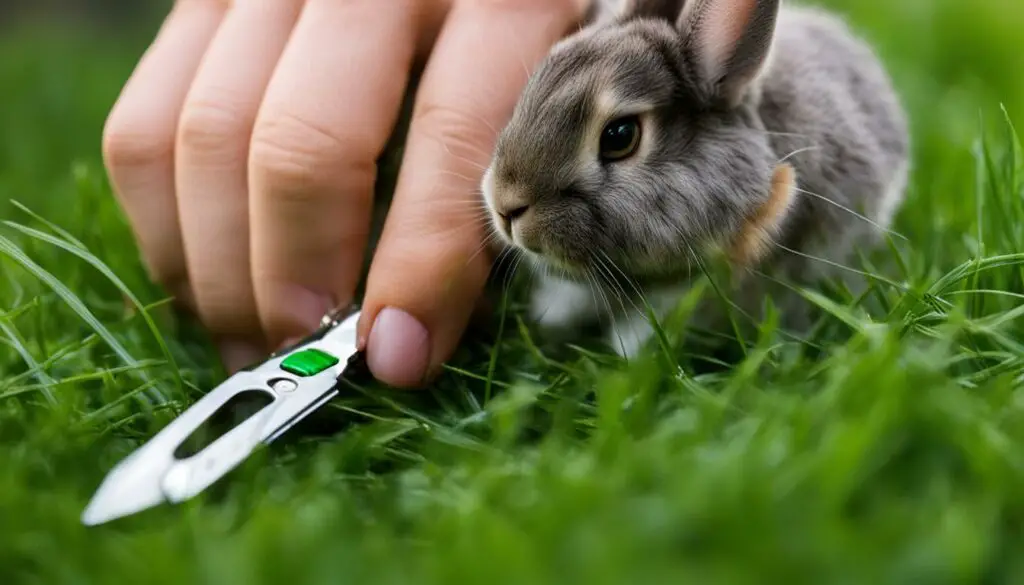
Trimming Nails: Things to Know
When it comes to trimming your rabbit’s nails, there are a few important things to keep in mind. These tips and facts can help make the process easier and ensure the safety and well-being of your bunny. Let’s explore some essential information about rabbit nail trimming:
The Importance of Regular Trimming
Regular nail trimming is crucial for rabbits to prevent potential issues. Long nails can cause discomfort, get caught on objects, or curl under, leading to sore hocks. By maintaining proper nail length, you can prevent these problems and ensure your bunny’s overall health and mobility.
Understanding Rabbit Nail Anatomy
Rabbit nails have a vein called the quick, which should not be cut or clipped. Accidentally cutting the quick can be painful and cause bleeding. Take time to familiarize yourself with the structure of your rabbit’s nails and locate the quick before attempting to trim them. Additionally, remember to trim only the tip of the nails to avoid any discomfort.
“Regular nail trimming is crucial for rabbits to prevent potential issues and ensure your bunny’s overall health and mobility.”
Tips for Successful Nail Trimming
Here are a few tips to make the nail trimming process smoother:
- Use nail clippers specifically designed for small animals or rabbits.
- Wrap your bunny in a towel to keep them calm and prevent scratches.
- If you accidentally cut into the quick and the nail starts bleeding, use a cotton swab with styptic powder or cornstarch to stop the bleeding.
- Consider using a pet nail file to smooth the nails after trimming.
- Provide plenty of treats and positive reinforcement to make the experience more pleasant for your bunny.
| Tip | Example |
|---|---|
| Use nail clippers specifically designed for small animals or rabbits. | Opt for Rabbit Nail Clippers available at pet supply stores. |
| Wrap your bunny in a towel to keep them calm and prevent scratches. | Gently secure your rabbit in a towel, leaving their paws exposed for easier access. |
| If you accidentally cut into the quick and the nail starts bleeding, use a cotton swab with styptic powder or cornstarch to stop the bleeding. | Apply a small amount of styptic powder to the bleeding nail using a cotton swab to encourage clotting. |
| Consider using a pet nail file to smooth the nails after trimming. | Use a pet nail file to gently file any rough edges or sharp points left after trimming. |
| Provide plenty of treats and positive reinforcement to make the experience more pleasant for your bunny. | Reward your rabbit with their favorite treats and praise them throughout the nail trimming process. |
Remember, always monitor your rabbit’s nail growth and trim them regularly to keep them at a comfortable length. Seeking guidance from a veterinarian or an experienced professional can also provide valuable insights and assistance.
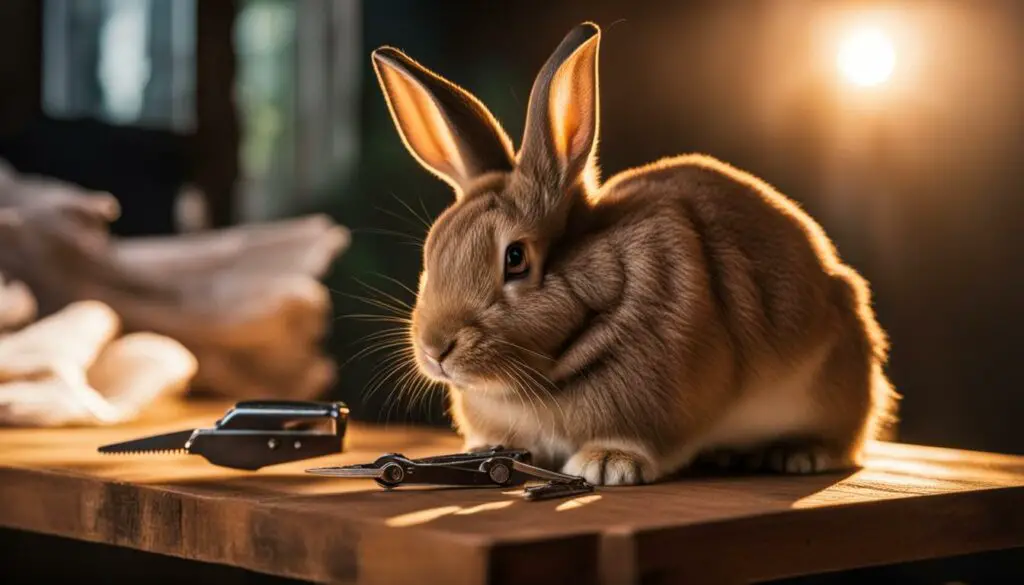
My First Nail Trimming Attempt
When I first attempted to trim my rabbit’s nails, I was filled with both excitement and a bit of nervousness. I had done my research and gathered all the necessary tools, but I was unsure of how my bunny would react. I carefully wrapped my bunny in a soft towel to keep them calm and prevent any accidents. As I began the process, I quickly realized that it required more patience and precision than I had anticipated.
One mistake I made was not properly observing the quick. I was so focused on trimming the nails that I accidentally cut into the quick, causing my bunny to yelp in pain. I immediately applied the styptic powder to stop the bleeding, but I knew I had made a mistake. From that moment on, I learned the importance of being extra cautious and paying close attention to the quick to avoid any discomfort for my bunny.
Another lesson I learned was to take breaks if my bunny seemed stressed or agitated. I realized that trying to rush through the process only made my bunny more anxious, making it even more difficult to trim their nails. By taking breaks and giving my bunny time to relax and calm down, I was able to resume the nail trimming with better results and without causing unnecessary stress.
“Learning from my mistakes, I have become more confident and skilled in trimming my rabbit’s nails. It’s all about finding the right technique and understanding your bunny’s comfort level.”
Overall, my first nail trimming attempt was a valuable learning experience. I discovered the importance of proper handling, closely observing the quick, and maintaining a calm and patient demeanor throughout the process. Learning from my mistakes, I have become more confident and skilled in trimming my rabbit’s nails. It’s all about finding the right technique and understanding your bunny’s comfort level. By continuously improving my approach and being attentive to my bunny’s cues, I have created a stress-free nail trimming routine that benefits both me and my bunny.
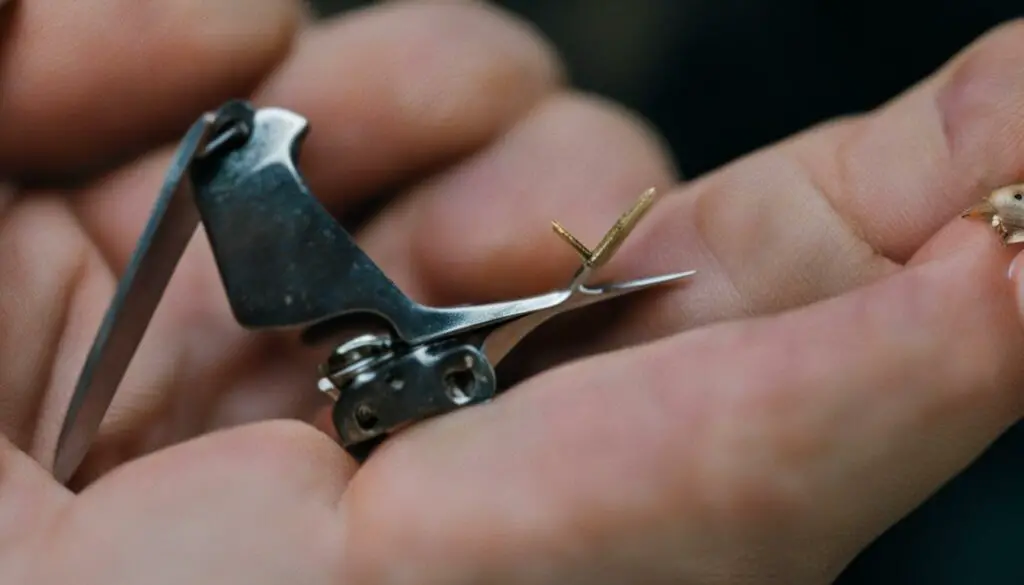
Gentle Techniques and Ongoing Learning
Each rabbit is unique, and what works for one may not work for another. It’s essential to remain patient and open-minded, adapting your technique to suit your bunny’s needs. By embracing a gentle and caring approach, and learning from any mistakes made along the way, you can ensure that nail trimming becomes a calm and positive experience for both you and your furry friend.
The Tools for Rabbit Nail Trimming
When it comes to trimming your rabbit’s nails, having the right tools can make the process much smoother and easier. Here are the essential tools you’ll need:
- Nail clippers specifically designed for small animals or rabbits. These clippers have the right size and shape to safely trim your rabbit’s nails without causing discomfort or injury. Avoid using regular human nail clippers, as they may not be suitable for your bunny’s nails.
- A pen light or bright light source. This will help you see the quick, the dark vein inside the nail that you want to avoid cutting. By illuminating the nail, you can ensure precision and prevent accidental injury.
- A nail file. After trimming your rabbit’s nails, it’s a good idea to smooth any rough edges. A nail file designed for pets can help you achieve a gentle and rounded finish.
- Cotton swabs and styptic powder. In case you accidentally cut the quick and the nail starts bleeding, having cotton swabs and styptic powder on hand can help stop the bleeding quickly. Apply the powder to the bleeding nail using the swab and apply gentle pressure until the bleeding stops.
- A thick towel and grooming glove. These can be used to provide comfort and restraint for your rabbit during the nail trimming process. The towel can be used to wrap your bunny securely and prevent any accidental scratches, while the grooming glove provides a soothing touch.
Having these essential tools ready before starting the nail trimming process will help you ensure a safe and effective experience for both you and your rabbit. Remember to always handle your bunny with care and patience, making the process as stress-free as possible.
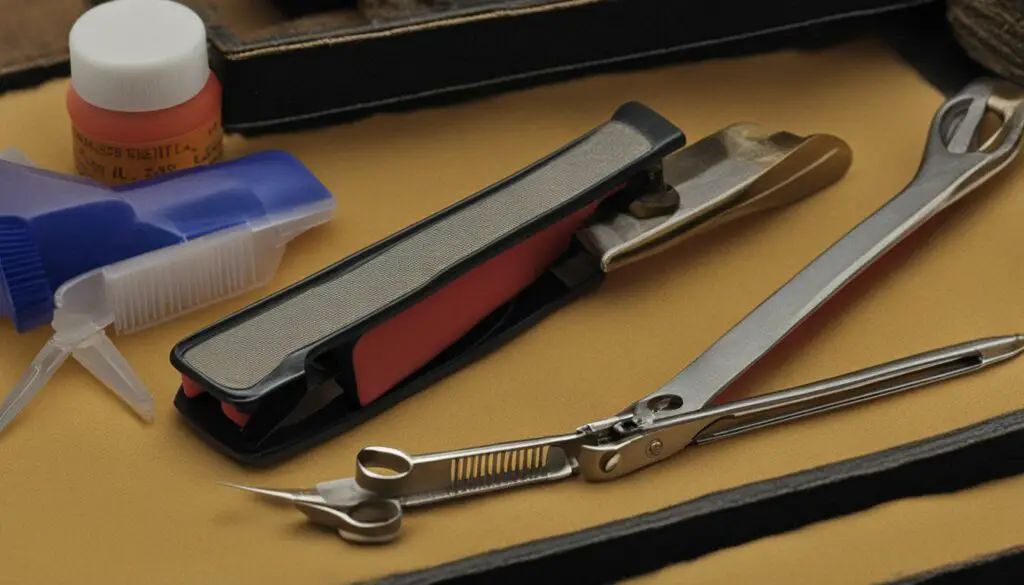
Choosing the Right Nail Clippers
When selecting nail clippers for your rabbit, it’s important to choose ones that are specifically designed for small animals or rabbits. These clippers are typically smaller in size with rounded edges, making them safer and more comfortable for your bunny.
Look for clippers with sharp blades that can make clean and precise cuts. Dull blades may cause cracking or splitting of the nail, which can be painful for your rabbit. Additionally, opt for clippers with a good grip, as this will help you have better control while trimming.
If you’re unsure about which nail clippers to choose, consult with your veterinarian or a professional groomer who can recommend the best options based on your rabbit’s specific needs.
Two Techniques for Trimming Nails
When it comes to trimming your rabbit’s nails, there are two primary techniques you can use. The first technique involves having the bunny lean slightly back, with one person doing the trimming. This approach allows for better visibility and control, as you can easily access each nail. However, some rabbits may feel uncomfortable or insecure in this position, so it’s important to gauge your bunny’s reaction and adjust accordingly.
The second technique involves having all four of the bunny’s feet flat on your lap, with two people involved in the process. One person holds and comforts the rabbit, while the other trims the nails. This technique can provide more support and security for the rabbit, especially if they are anxious or fidgety. However, it can be more challenging to see and access the back nails, so proper handling and teamwork are essential.
Ultimately, the choice of technique depends on your rabbit’s personality and comfort level, as well as your own confidence and ability to handle the process. It’s important to prioritize the safety and well-being of your rabbit throughout the nail trimming process.
Trimming Nails: Step-by-Step
Trimming your rabbit’s nails can be a straightforward process when done correctly. Follow these step-by-step instructions to ensure a safe and successful nail trimming session for your furry friend. Remember to take necessary safety precautions and maintain a calm and gentle approach throughout the process.
Step 1: Prepare the Tools
Gather all the necessary tools before you begin. You will need a towel, nail clippers specifically designed for rabbits, cotton swabs, and styptic powder or cornstarch in case of any bleeding. It’s also useful to have a pet nail file and a grooming glove for additional comfort.
Step 2: Securely Hold Your Rabbit
Place a towel on your lap or a sturdy surface and gently secure your rabbit in a comfortable and secure position. Make sure their body is well-supported, allowing you easy access to their nails. Speak softly and provide reassurance to keep them calm throughout the process.
Step 3: Identify the Quick
Before you start trimming, identify the quick in each nail. The quick is the dark vein that runs through the nail and should be avoided during the trimming process. Gently squeeze each nail to locate the quick. Be cautious with darker nails as it may be harder to see. Only trim the tip of the nail, well clear of the quick, to avoid any pain or bleeding.
Following these steps will help you trim your rabbit’s nails safely and effectively. Remember to provide treats and positive reinforcement after each successful trimming session to reward your bunny and make the experience more enjoyable for both of you.
Conclusion
In conclusion, rabbit nail trimming is an essential aspect of their overall health and well-being. By regularly maintaining their nails, we can prevent discomfort and potential complications caused by long nails. It is crucial to follow proper techniques, such as observing the quick and making precise cuts, to ensure a safe and pain-free experience for our furry friends.
While nail trimming can be a challenging task, it becomes easier with practice. Patience, gentle handling, and using the right tools are key to successful nail trimming sessions. Remember to provide a calming environment and rewards to help your rabbit associate the process with positive experiences.
Additionally, it is important to explore natural ways to help keep your rabbit’s nails shorter, such as providing different surfaces for them to walk on and creating a digging box. Regular exercise and ample space for them to run can also contribute to maintaining proper nail length.
By prioritizing rabbit nail care and following the guidelines provided, we can ensure that our bunnies lead healthy and comfortable lives. Remember, a little effort in maintaining their nails goes a long way in promoting their overall happiness and well-being.
FAQ
How often should I trim my rabbit’s nails?
It is recommended to check your rabbit’s nails every week or so, and start with trimming every three weeks to one month. The exact time between trims may vary depending on the rabbit.
How many nails does a rabbit have?
Rabbits have a total of eighteen nails, with four nails on each back paw and five on each front paw.
What is the dark line on a rabbit’s nail?
The dark line is called the quick, which is a vein that should not be cut or clipped. Accidentally cutting the quick can be painful for the rabbit and lead to bleeding.
Can I declaw my rabbit?
Declawing a rabbit is strongly discouraged and considered inhumane. It can cause pain, mobility issues, and prevent them from engaging in natural behaviors.
Are there natural ways to keep rabbit nails shorter?
Yes, providing different surfaces for them to walk on, creating a digging box, and giving them ample exercise can help naturally wear down their nails.
What problems can long rabbit nails cause?
Long nails can get snagged easily, causing injuries or dislocation. They can also cause weight distribution problems and lead to sore hocks and joint strain.
What tools do I need for rabbit nail trimming?
You will need nail clippers specifically designed for small animals, a towel, cotton swabs, styptic powder or cornstarch, and optionally, a pet nail file and a grooming glove.
What are the different techniques for trimming rabbit nails?
There are two main techniques: one person trimming with the bunny leaning slightly back, or two people with all four bunny feet flat on the lap. The choice depends on the rabbit’s comfort level and the handler’s confidence.
Can you provide a step-by-step guide for trimming rabbit nails?
Sure! In Section 12, there is a detailed step-by-step guide that will walk you through the process of trimming your rabbit’s nails safely and effectively.
Is rabbit nail trimming important?
Yes, regular nail trimming is important to prevent various issues and maintain your rabbit’s overall health and well-being.

